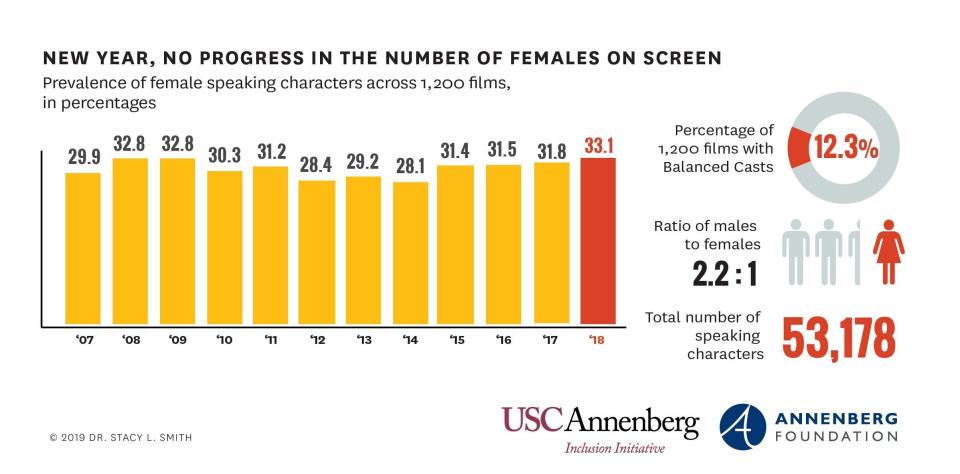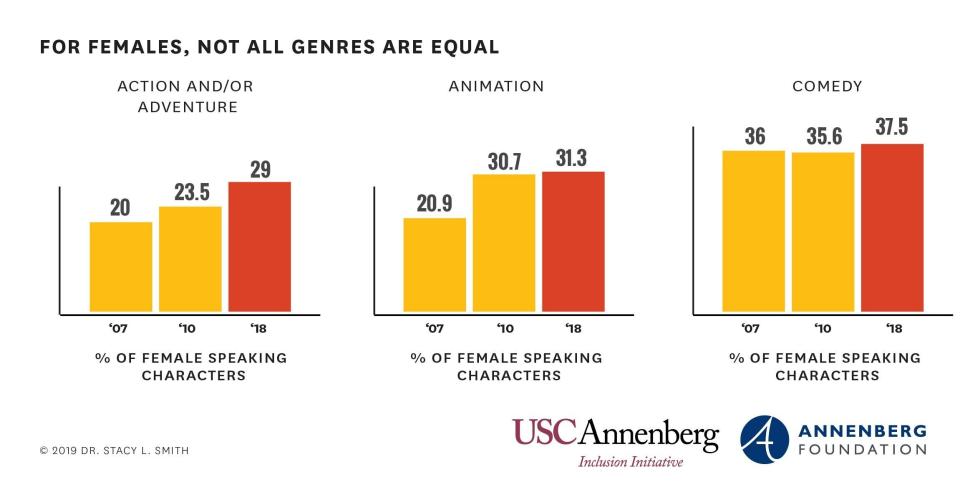'Black Panther' And 'Crazy Rich Asians' Won't Solve Hollywood's Diversity Problem
The seismic success of last year’s “Black Panther” and “Crazy Rich Asians” has helped demolish the longstanding myth that Hollywood movies by and about people of color don’t sell at the box office, and brought cautious optimism that the entertainment industry is finally trying to better portray historically underrepresented groups.
A new study released Wednesday confirms that those movies brought gains in diversity and representation — but also warns that Hollywood shouldn’t rest on its laurels because there are still longstanding inequities.
Thanks in part to the landmark blockbusters, speaking roles for Black and Asian actors in 2018 increased to their highest level in more than 10 years, according to the study by University of Southern California professor Stacy L. Smith and the Annenberg Inclusion Initiative, which has long studied representation in Hollywood.
Examining 53,178 characters in the top 100 highest-grossing movies from 2007 to 2018 (a total of 1,200 movies), Smith and her team found that speaking roles for “underrepresented racial/ethnic groups” — defined as Black, Latino, Asian, Middle Eastern or North African, Native American, Pacific Islander, or multiracial — increased from 29.3% in 2017 to 36.3% in 2018.
The study also found gains in the number of leading roles for women, women of color, and older women.
But there remains systemic inequality, and one year of success does not guarantee long-term progress, which similar studies have demonstrated again and again.
“Despite more than a decade of advocacy, the percentage of female speaking characters has not increased,” Smith said in a statement. “Additionally, we saw no substantial improvement in the percentage or representation of LGBTQ characters or characters with disabilities. It is crucial not to lose sight of these, and other areas, that still need to improve.”
The study notes that many marginalized groups saw little, if any, gain in representation, and were all but erased from major Hollywood movies. Among the top 100 highest-grossing films of 2018, less than 2% of characters on-screen had a disability, which the study’s authors say is a four-year low. In addition, LGBTQ characters made up only 1.3% of speaking roles in 2018′s top 100 movies.
A number of racial and ethnic groups remained sorely underrepresented, despite the gains overall; There were few Middle Eastern and North African characters, Native American characters or Pacific Islander characters on-screen, the study showed.

And while women are getting to lead more blockbuster movies, the number of speaking roles for women overall has barely improved. In the top 100 movies at the box office in 2018, women had 33.1% of the speaking roles. That has hovered either just below or above 30% in each of the 12 years that researchers have conducted the study.
The study notes that “not all genres are equal,” pointing out, for example, that women made smaller gains in action and adventure movies, compared with other genres. And women in major movies are still far more likely to be portrayed as sex objects than their male counterparts.

The study reinforces many findings from similar assessments of diversity and representation (or lack thereof) in pop culture. Some of those note the importance of diversity in Hollywood’s gatekeepers and people in behind-the-scenes roles, such as executives, producers, directors and writers.
For example, “one explanation for the increase in Black characters can be found behind the camera, as the number of Black directors rose from 6 in 2017 to 15 across the 100 top movies of 2018,” the new study’s authors wrote. Prior research has found that there has been no meaningful change in the number of women directing major Hollywood movies, or in elevating women and people of color in leadership roles.
The authors also recommend combating implicit bias in hiring, such as employing more inclusive casting processes and avoiding links “between a lead character’s identity and that of the film director,” such as wrongly assuming that only male directors can direct male roles.
Read the full study and its methodology here.
Love HuffPost? Become a founding member of HuffPost Plus today.
Related Coverage
Audiences Want Diversity In Hollywood. Hollywood's Been Slow To Get The Message.
Women, People Of Color Still Abysmally Underrepresented In Hollywood Leadership
The Proportion Of Women Directing Top Hollywood Movies Actually Dropped In 2018
Latino Characters Make Up A Tiny Fraction Of Characters On-Screen
Asian Creators Are Making Strides In Hollywood, But There's Still A Long Way To Go
This article originally appeared on HuffPost.

